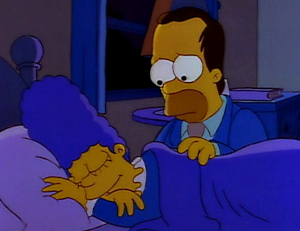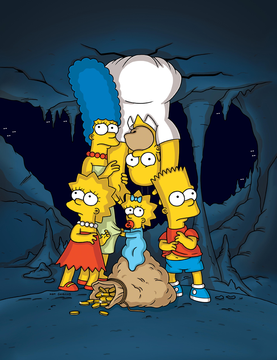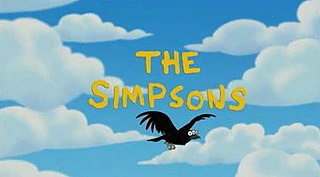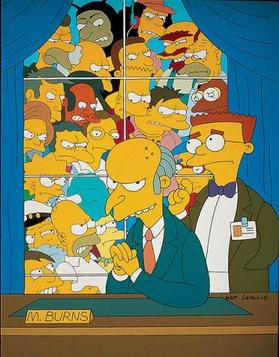Marjorie Jacqueline "Marge" Simpson (née Bouvier) is a character in the American animated sitcom The Simpsons and part of the eponymous family. Voiced by Julie Kavner, she first appeared on television in The Tracey Ullman Show short "Good Night" on April 19, 1987. Marge was created and designed by cartoonist Matt Groening while he was waiting in the lobby of James L. Brooks' office. Groening had been called to pitch a series of shorts based on Life in Hell but instead decided to create a new set of characters. He based the character on his mother Margaret Groening. After appearing on The Tracey Ullman Show for three seasons, the Simpson family received their own series on Fox, which debuted December 17, 1989.

Margaret "Maggie" Simpson is a fictional character in the animated television series The Simpsons and the youngest member of the Simpson family. She first appeared on television in the Tracey Ullman Show short "Good Night" on April 19, 1987. Maggie was created and designed by cartoonist Matt Groening while he was waiting in the lobby of James L. Brooks' office. She received her first name from Groening's youngest sister. After appearing on The Tracey Ullman Show for three years, the Simpson family was given their own series on the Fox Broadcasting Company which debuted December 17, 1989.
"She of Little Faith" is the sixth episode of the thirteenth season of the American animated television series The Simpsons. It first aired in the United States on the Fox network on December 16, 2001. In the episode, Bart Simpson and his father Homer accidentally launch a model rocket into the Springfield church, causing the church council to accept funding plans from Mr. Burns for reparation. Discontent with how commercialized the rebuilt church has become, Lisa abandons Christianity and seeks out to follow a new religion.
"A Tale of Two Springfields" is the second episode of the twelfth season of the American animated television series The Simpsons, and the 250th episode of the series overall in both broadcast and production order. It originally aired on the Fox network in the United States on November 5, 2000. In the episode, Homer discovers that Springfield has two different area codes and ends up leading a revolt that splits the town in two.

The Simpson family are the main fictional characters featured in the animated television series The Simpsons. The Simpsons are a nuclear family consisting of married couple Homer and Marge and their three children, Bart, Lisa, and Maggie. They live at 742 Evergreen Terrace in the fictional town of Springfield, United States, and they were created by cartoonist Matt Groening, who conceived the characters after his own family members, substituting "Bart" for his own name. The family debuted on Fox on April 19, 1987, in The Tracey Ullman Show short "Good Night" and were later spun off into their own series, which debuted on Fox in the U.S. on December 17, 1989, and started airing in Winter 1989.

"Lisa Gets an 'A'" is the seventh episode of the tenth season of the American animated television series The Simpsons. It first aired on the Fox network in the United States on November 22, 1998. In the episode, Lisa cheats on a test for which she fails to study and receives an A+++ grade, but becomes guilt-ridden. In the subplot, Homer buys a lobster with the intention of fattening him up to eat, but he bonds with the crustacean and keeps him as a pet named Pinchy.
Joseph Stewart Burns, better known as J. Stewart Burns or simply just Stewart Burns is a television writer and producer most notable for his work on The Simpsons, Futurama, and Unhappily Ever After.

"The Blunder Years" is the fifth episode of the thirteenth season of the American animated television series The Simpsons. It originally aired on the Fox network in the United States on December 9, 2001. The episode sees Homer, after being hypnotized by the hypnotist Mesmerino while having dinner at the restaurant Pimento Grove, reminded by a repressed traumatic experience from his childhood, including the moment he discovered the dead body of Waylon Smithers' father while having a fun at an abandoned mine. The Simpsons set out to find the corpse that triggered Homer's psychological trauma, which evolves into a murder mystery later in the episode.
"Large Marge" is the fourth episode of the fourteenth season of the American animated television series The Simpsons. It originally aired on the Fox network in the United States on November 24, 2002. In the episode, Marge decides to get liposuction, thinking that Homer does not find her attractive anymore. However, she accidentally receives breast implants, so she becomes adored by many men in Springfield and becomes a model. Meanwhile, Bart and Milhouse try to imitate a stunt they saw on an episode of Batman that guest starred Krusty the Clown. When the stunt ends badly, media watchdog groups blame Krusty, forcing the clown to make his show more safety-conscious and less fun.
Ian Maxtone-Graham is an American television writer and producer. He has formerly written for Saturday Night Live (1992–1995) and The Simpsons (1995–2012), as well as serving as a co-executive producer and consulting producer for the latter.

"I Married Marge" is the eleventh episode of the third season of the American animated television series The Simpsons. It originally aired on the Fox network in the United States on December 26, 1991. In the episode, Marge worries that she may be pregnant again and visits Dr. Hibbert's office. While anxiously waiting at home, Homer tells Bart, Lisa, and Maggie the story of his and Marge's marriage and Bart's birth. The episode was written by Jeff Martin and directed by Jeffrey Lynch.

"The Seemingly Never-Ending Story" is the thirteenth episode of the seventeenth season of the American animated television series The Simpsons. It originally aired on the Fox network in the United States on March 12, 2006. The episode won the Primetime Emmy Award for Outstanding Animated Program. At the 34th Annie Awards, episode writer Ian Maxtone-Graham won the award for "Best Writing in an Animated Television Production." The episode contains many levels of nested storytelling, much like the novel The NeverEnding Story by Michael Ende, which the title references.

The Simpsonsopening sequence is the title sequence of the American animated television series The Simpsons. It is accompanied by "The Simpsons Theme". The first episode to use this introduction was the series' second episode "Bart the Genius".

"24 Minutes" is the twenty-first episode of the eighteenth season of the American animated television series The Simpsons. It originally aired on the Fox network in the United States on May 20, 2007 as part of the one-hour season finale, alongside the episode "You Kent Always Say What You Want". It was originally promoted as being the 400th episode, but was broadcast as the 399th. It was written by Ian Maxtone-Graham and Billy Kimball. It was Kimball's first writing credit.

"Who Shot Mr. Burns?" is a two-part episode of the American animated television series The Simpsons.Part One is the twenty-fifth and final episode of the sixth season and originally aired on the Fox network in the United States on May 21, 1995, while Part Two is the season premiere of the seventh season and aired on September 17, 1995.

"Homer of Seville", also known as "The Homer of Seville", is the second episode of the nineteenth season of the American animated television series The Simpsons. It first aired on the Fox network in the United States on September 30, 2007. In the episode, Homer gains an operatic ability to sing following an accident, and becomes a professional and famous opera star. While running from a mob of crazed fans, he is saved by Julia, a beautiful and dangerous stalker.
"The Burns and the Bees" is the eighth episode of the twentieth season of the American animated television series The Simpsons. It first aired on the Fox network in the United States on December 7, 2008. In the episode, during a poker game, Mr. Burns wins ownership of the Austin Celtics basketball team and he decides to build a new stadium in Springfield that endangers a bee colony which Lisa built. Lisa's subplot refers to the current worldwide disappearance of bees.

"Treehouse of Horror XXIII" is the second episode of the twenty-fourth season of the American animated television series The Simpsons. The episode was directed by Steven Dean Moore and written by David Mandel and Brian Kelley. It first aired on the Fox network in the United States on October 7, 2012. In the United Kingdom and Ireland, the episode aired on Sky 1 on March 24, 2013 with 1,312,000 viewers, making it the most watched program that week. The episode received an Emmy nomination for Outstanding Animated Program.
"Halloween of Horror" is the fourth episode of the twenty-seventh season of the American animated television series The Simpsons, and the 578th episode of the series overall. The episode was directed by Mike B. Anderson and written by Carolyn Omine. It originally aired in the United States on Fox on October 18, 2015.











